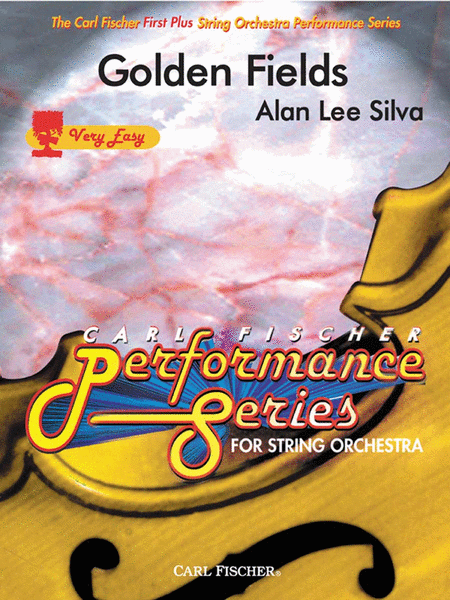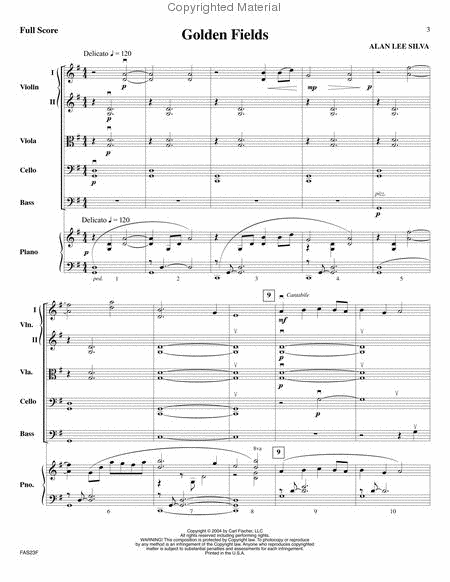Golden Fields
Full Score and Parts
-
Ships in 1 to 2 weeks
Details
Description
SKU: CF.FAS23
Full Score and Parts. Composed by Alan Lee Silva. Carl Fischer First Plus String Orchestra Series. Score and Parts. With Standard notation. 8+8+8+2+5+5+5+3 pages. Carl Fischer Music #FAS23. Published by Carl Fischer Music (CF.FAS23).ISBN 9780825854750. UPC: 798408054755. 8.5 X 11 inches. Key: G major.
Movie and Television writer Alan Silva gives us this wistful new original tune for developing string players. With bold strokes that are reminiscent of film music, Golden Fields offers students playability that is both melodic and tuneful. Wonderfully orchestrated with lots of variety, this piece offers each student the opportunity to play an important role in the performance of this piece.
Golden Fields is an engaging variation on the americana style in AABa form. In the introductory bars, the open-string double-stops (which can also be performed by two players) allow young musicians to focus on intonation by playing sustained notes as part of an ensemble voicing. At m. 9, the violins should play the melody with a singing quality over open fifths and pedal points in the lower strings. The cello take over the melody at m. 17, beginning the build to the first soaring B section. The B sections (beginning at mm. 25, 41, 49) are the climaxes of the piece and should be played the most energetically. The descending pyramid sequence beginning in m.37 gives each section a chance to count and listen for their individual entrances. The ensemble chords at m. 48 and m. 56 and 57 should be played with strength and accuracy, as they provide a surprise break in the fluidity of the melody. The long ensemble crescendo beginning in m. 58 to the final descending scale in the low strings provides a satisfying close, culminating in a delicate final chord.
Golden Fields is an engaging variation on the americana style in AABa form. In the introductory bars, the open-string double-stops (which can also be performed by two players) allow young musicians to focus on intonation by playing sustained notes as part of an ensemble voicing. At m. 9, the violins should play the melody with a singing quality over open fifths and pedal points in the lower strings. The cello take over the melody at m. 17, beginning the build to the first soaring B section. The B sections (beginning at mm. 25, 41, 49) are the climaxes of the piece and should be played the most energetically. The descending pyramid sequence beginning in m.37 gives each section a chance to count and listen for their individual entrances. The ensemble chords at m. 48 and m. 56 and 57 should be played with strength and accuracy, as they provide a surprise break in the fluidity of the melody. The long ensembleA crescendo beginning in m. 58 to the final descending scale in the low strings provides a satisfying close, culminating in a delicate final chord.
Golden Fields is an engaging variation on the americana style in AABa form. In the introductory bars, the open-string double-stops (which can also be performed by two players) allow young musicians to focus on intonation by playing sustained notes as part of an ensemble voicing. At m. 9, the violins should play the melody with a singing quality over open fifths and pedal points in the lower strings. The cello take over the melody at m. 17, beginning the build to the first soaring B section. The B sections (beginning at mm. 25, 41, 49) are the climaxes of the piece and should be played the most energetically. The descending pyramid sequence beginning in m.37 gives each section a chance to count and listen for their individual entrances. The ensemble chords at m. 48 and m. 56 and 57 should be played with strength and accuracy, as they provide a surprise break in the fluidity of the melody. The long ensemble crescendo beginning in m. 58 to the final descending scale in the low strings provides a satisfying close, culminating in a delicate final chord.
Golden Fields is an engaging variation on the americana style in AABa form. In the introductory bars, the open-string double-stops (which can also be performed by two players) allow young musicians to focus on intonation by playing sustained notes as part of an ensemble voicing. At m. 9, the violins should play the melody with a singing quality over open fifths and pedal points in the lower strings. The cello take over the melody at m. 17, beginning the build to the first soaring B section. The B sections (beginning at mm. 25, 41, 49) are the climaxes of the piece and should be played the most energetically.The descending pyramid sequence beginning in m.37 gives each section a chance to count and listen for their individual entrances. The ensemble chords at m. 48 and m. 56 and 57 should be played with strength and accuracy, as they provide a surprise break in the fluidity of the melody. The long ensemble crescendo beginning in m. 58 to the final descending scale in the low strings provides a satisfying close, culminating in a delicate final chord.



 Share
Share